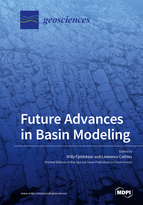Future Advances in Basin Modeling: Suggestions from Current Observations, Analyses, and Simulations
A special issue of Geosciences (ISSN 2076-3263). This special issue belongs to the section "Structural Geology and Tectonics".
Deadline for manuscript submissions: closed (31 August 2019) | Viewed by 61184
Special Issue Editors
Interests: basin modelling; structural deveopment; tectonic processes; thermal regime; post glacial rebound
Special Issue Information
Dear Colleagues,
The intent of this special issue is to assemble a set or papers that describe the nature, causes, and consequences of the diverse fluid movements that occur in basins. The papers will provide a perspective of what could be added in the next generation of basin models. The twelve already committed papers describe the impact of magmatic sill intrusion and salt migration on maturation (incorporating fault movements), gas movements in the South China Sea, the maturation of Paleozoic source rock in the Llanos Basin of Colombia, the dynamic venting of H2 gas from Paleozoic formations, alteration and permeability modification related to petroleum migration, the impact of multiple glaciations on maturation and migration, and the detection of flow pathways using passive seismic techniques. Papers not yet committed could address secondary migration, determination of thermal conductivity from well log profiles, and gas desorption following glacial unloading. Fundamental questions such as continental lithosphere thickness and the characterization of unconventional hydrocarbon resources might also be included.
The volume will be available free online and the cost per author is minimal, so its impact will depend on the quality and novelty of the included papers. Our intent is to distribute and update a list of tentative titles as papers are committed so that authors can see how their contribution fits into the overall context of the volume. Articles will be published as soon as they are accepted. The suggested August 31, 2019 deadline is not a firm deadline for the volume. Important contributions will be accepted after this date.
Dr. Willy Fjeldskaar
Prof. Lawrence Cathles
Guest Editors
Manuscript Submission Information
Manuscripts should be submitted online at www.mdpi.com by registering and logging in to this website. Once you are registered, click here to go to the submission form. Manuscripts can be submitted until the deadline. All submissions that pass pre-check are peer-reviewed. Accepted papers will be published continuously in the journal (as soon as accepted) and will be listed together on the special issue website. Research articles, review articles as well as short communications are invited. For planned papers, a title and short abstract (about 100 words) can be sent to the Editorial Office for announcement on this website.
Submitted manuscripts should not have been published previously, nor be under consideration for publication elsewhere (except conference proceedings papers). All manuscripts are thoroughly refereed through a single-blind peer-review process. A guide for authors and other relevant information for submission of manuscripts is available on the Instructions for Authors page. Geosciences is an international peer-reviewed open access monthly journal published by MDPI.
Please visit the Instructions for Authors page before submitting a manuscript. The Article Processing Charge (APC) for publication in this open access journal is 1800 CHF (Swiss Francs). Submitted papers should be well formatted and use good English. Authors may use MDPI's English editing service prior to publication or during author revisions.
Keywords
- Structural evolution
- Thermal development
- Diagenesis
- Hydrocarbon maturation
- Migration of hydrocarbons
- Unconventional resources
- Geophysical monitoring
Related Special Issues
- Natural Gas Origin, Migration, Alteration and Seepage in Geosciences (6 articles)
- Geostatistical Applications in Petroleum Geology in Geosciences (7 articles)
- Temperature in Sedimentary Basins in Geosciences (7 articles)






